The volcanoes in El Salvador range from towering stratovolcanoes such as Izalco, Santa Ana, San Vicente, and Chaparrastique to eroded volcanoes resembling a mountain such as Guazapa and Cerro Verde.
El Salvador is called the land of volcanoes because it has 170 volcanoes in its territory and lies in the Pacific Ring of Fire, one of the areas with the most seismic and volcanic activity on the planet.
El Salvador has 23 active volcanoes, of which six are frequently monitored for seismic activity. They are the Santa Ana, Izalco, San Salvador, San Vicente, and Chaparrastique stratovolcanoes; the Ilopango volcanic Caldera is also observed.
- Number of Volcanoes
- Active Volcanoes
- Most Popular Volcanoes
- 1. Santa Ana Volcano
- 2. Izalco Volcano
- 3. San Salvador Volcano
- 4. Chaparrastique Volcano
- 5. Chinchontepec Volcano
- 6. Conchagua Volcano
- 7. Ilopango Caldera
- 8. Cerro Verde Volcano
- 9. Guazapa Volcano
- 10. Tecapa Volcano
- Best Way to Explore Salvadoran Volcanoes
- Volcano’s Importance to El Salvador

SEE ALSO: El Salvador Tourism: A Journey Through Pristine Beaches, Colorful Towns, and Enchanting Parks
How Many Volcanoes Are in El Salvador?
There are 170 volcanoes in El Salvador scattered in a territory of 21,041 square kilometers. El Salvador is a small nation with dense volcanic activity. In fact, 90% of the Salvadoran territory has volcanic materials.
According to some geological studies, most of these volcanoes were formed by a collision of tectonic plates over 10,000 years ago. But, some volcanoes have been created more recently from holes in the slopes of other volcanoes.
According to MARN volcanologists, the emergence of volcanoes in El Salvador was facilitated by its close location to two tectonic plates.
The Cocos tectonic plate is 50 kilometers off the Salvadoran coast and collides with the Caribbean plate. El Salvador is in the collision zone of both plates; this facilitates the formation of volcanoes.
Active Volcanoes in El Salvador
El Salvador has 23 active volcanoes, six of which are frequently monitored for seismic activity. They are the volcanoes Santa Ana, Izalco, San Salvador, San Vicente, Chaparrastique, and the Ilopango Caldera.
A division of the Ministry of the Environment (MARN) is the governmental agency overseeing the monitoring of these active volcanoes.
| Name | Type Altitute |
Location | Last Eruption |
|
|---|---|---|---|---|
| 1 | Santa Ana | Stratovolcano 2,382 |
Santa Ana | 2005 |
| 2 | Izalco | Stratovolcano 1,965 |
Sonsonate | 1966 |
| 3 | San Salvador | Stratovolcano 1,867 |
San Salvador | 1917 |
| 4 | San Vicente | Stratovolcano 2,173 |
San Vicente | N/A |
| 5 | Chaparrastique | Stratovolcano 2,130 |
San Miguel | 1976 |
| 6 | Burnt Islands Ilopango |
Lava Dome 450 |
San Salvador | 1880 |
| Ilopango | Caldera 438 |
San Salvador | 429 AD |
SEE ALSO: El Salvador’s Ecotourism. 10 Incredible Salvadoran Natural Parks Worth Exploring!
Most Popular Salvadoran Volcanoes
The most popular Salvadoran volcanoes are the Santa Ana, Izalco, San Salvador, Chaparrastique, San Vicente, and Conchagua. The Ilopango volcanic caldera and the Cerro Verde, Guazapa, and Tecapa volcanic mountains are also well-known.
1. Santa Ana Volcano
The Santa Ana or Ilamatepec volcano is the tallest in El Salvador; it stands at 2,382 meters above sea level; it is one of the most visited in the country.
The Santa Ana volcano is popular with local and foreign tourists. Hiking to the summit is one of the most popular tourist activities. Yet, hiking Santa Ana is not for everyone; the trails are narrow and challenging.
Nevertheless, anyone who reaches the top will be rewarded with a fantastic view of the other two volcanoes in the park, the crater lake inside the volcano, the Coatepeque Lake, the Pacific Ocean, and a 360-degree unobstructed view of the entire region.
The Santa Ana volcano is located in the Apaneca mountain range at the Cerro Verde National Park near the city of Santa Ana.
SEE ALSO: The Santa Ana Volcano in El Salvador or Ilamatepec Volcano
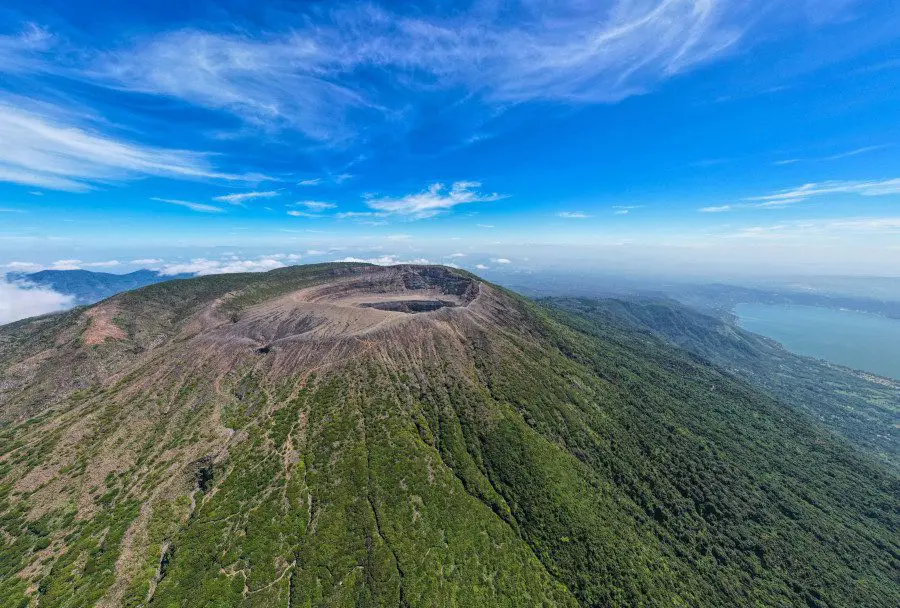
2. Izalco Volcano
Izalco is one of the youngest volcanoes on the American Continent; it is an iconic stratovolcano located at the Cerro Verde National Park.
This volcano is also called the lighthouse of the Pacific. It got the nickname from the flaring eruptions and the lava coming out. This flaring event was visible from the Pacific Ocean, therefore looking like a lighthouse in the distance.
This volcano, just like Santa Ana, is a popular destination for those looking to hike a volcano summit.
The hike is challenging, even for experienced hikers; nevertheless, once you reach the top, you’ll be rewarded with spectacular panoramic views of the entire area.
The Izalco volcano has no vegetation; therefore, the perfect volcano cone is visible from afar. One of the best locations to see this fantastic stratovolcano is from the lookout points at the Cerro Verde National Park.
SEE ALSO: Izalco Volcano El Salvador. The Lighthouse of the Pacific.
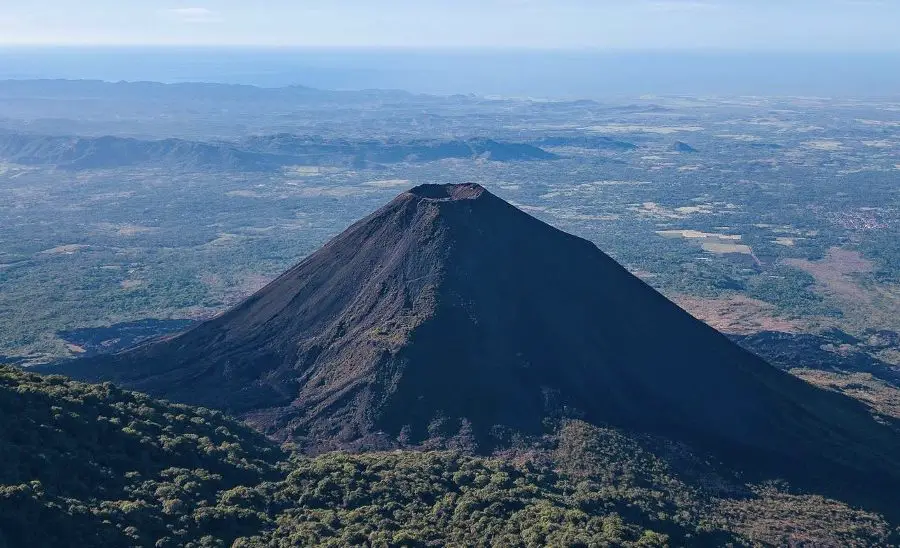
3. San Salvador Volcano
The San Salvador volcano, also known as Quezalatepeque volcano, is a stratovolcano located about eleven kilometers from San Salvador, the nation’s capital. It sits at an elevation of 1,667 meters above sea level.
This volcano last erupted in 1917. This eruption caused the extinction of the volcano crater lake. The now-empty volcano crater called El Boqueron is one of the main attractions of the volcano.
The volcano is near heavily populated areas; therefore, it gets plenty of visitors, most of whom visit through the El Boqueron National Park.
El Boqueron National Park is located within the stratovolcano; it has well-marked trails that take visitors to the top and see the famous El Boqueron crater and El Boqueroncito.
The main volcanic crater at El Boqueron is about 1.5 km in width and about 500 meters deep; El Boqueroncito is located inside the main volcano crater.
SEE ALSO: The San Salvador Volcano. Iconic background of the Nation’s capital.
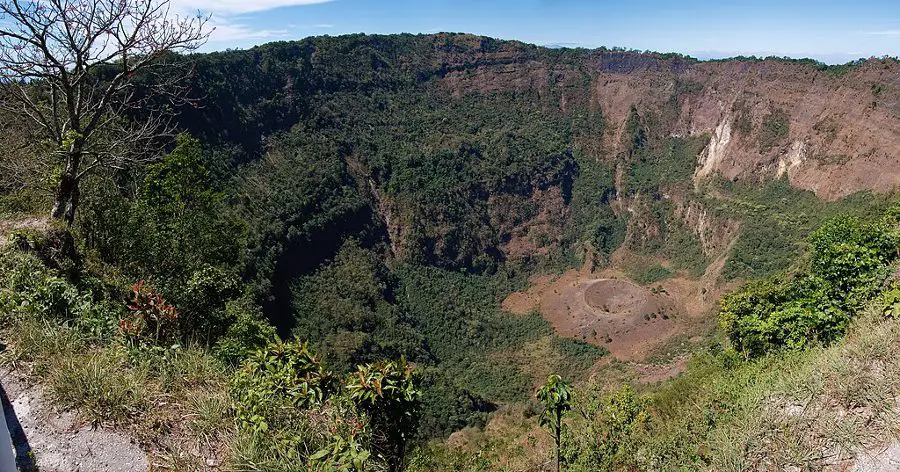
4. Chaparrastique or San Miguel Volcano
The Chaparrastique volcano, or volcano of San Miguel, is located in the eastern part of the country. This massive stratovolcano is visible from many lookout points near the volcano or from the city of San Miguel.
If you are adventurous enough to want to hike Chaparrastique, keep in mind the following. This volcano is not protected by any national park and has official trails to follow. The Chaparrastique volcano is there for anyone with the courage to explore it.
Also, this fierce-looking volcano is one of the most active in the country; the last big eruption was in 1976. However, in 2022 and 2023, the volcano had seismic activity that included smoke coming out of its crater. .
SEE ALSO: Chaparrastique Volcano in El Salvador: San Miguel’s Active Beauty
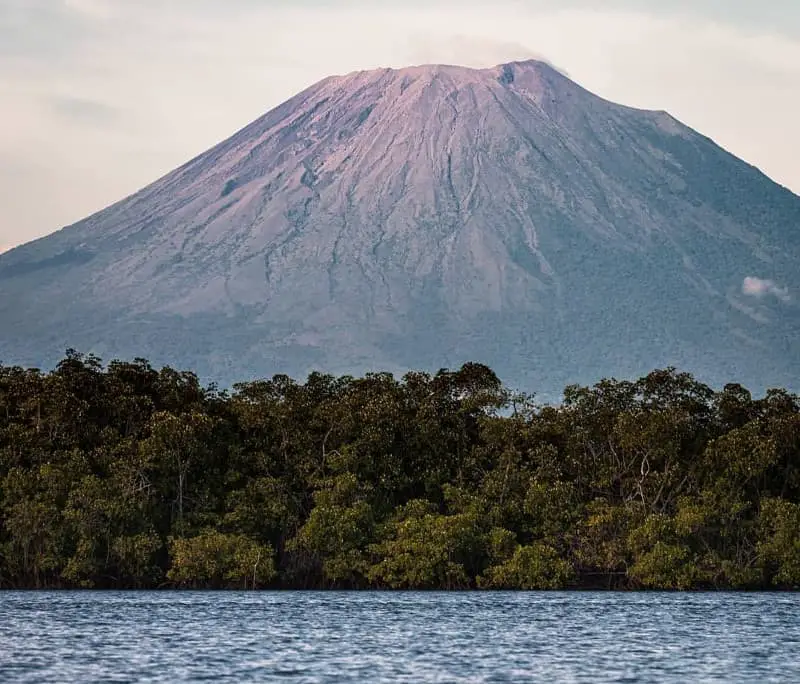
5. Chinchontepec Volcano
The San Vicente, or Chichontepec volcano, is the second tallest in the country. This massive twin-peaked volcano, just like Chaparrastique, is not suitable for everyone to explore or hike.
The volcano is surrounded by dense vegetation; therefore, getting to the summit or high up is the best and only way to see the surrounding areas.
Getting to the top is challenging as the trails are not accurately maintained or marked. Nonetheless, if you reach the summit or high up, you will get great views of the area.
On a clear day from the San Vicente volcano summit, you can see the other two large volcanos in the distance, Chaparrastique in San Miguel and Ilamatepec in Santa Ana.
SEE ALSO: San Vicente Volcano El Salvador or Chichontepec Volcano.

6. Conchagua Volcano
Conchagua volcano is a stratovolcano located in southeastern El Salvador, near the city of La Union; Conchagua overlooks the Gulf of Fonseca.
The volcano is surrounded by dense vegetation, but there are plenty of trails for visitors to explore and enjoy the local flora and fauna. Furthermore, you can go camping in the area.
SEE ALSO: Conchagua Volcano El Salvador. Beautiful Stratovolcano Overlooking the Fonseca Gulf
This volcano is not as famous as other volcanoes in the country, primarily because it is farther away from the larger cities and is not easy to get to.

7. Ilopango Caldera
Ilopango is an active volcano caldera Lake popular with local and foreign tourists. The caldera is on the outskirts of San Salvador. Diving is an excellent option at this caldera lake.
The Ilopango Caldera is one of the six volcanoes monitored by the Salvadoran Government.
Ilopango was the location of one of the most catastrophic eruptions in the world. 1,500 years ago, it erupted and released up to 84 cubic kilometers of volcanic material.
SEE ALSO: Lake Ilopango El Salvador: El Salvador’s Enigmatic Crater Lake
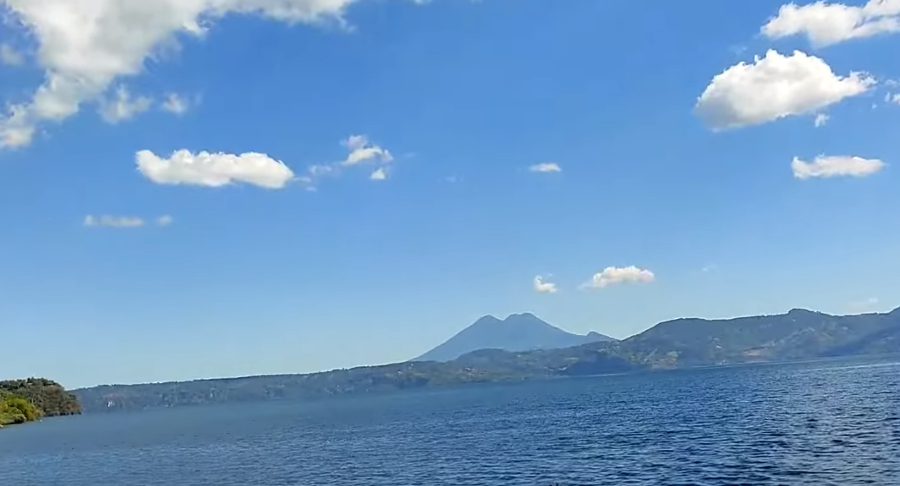
8. Cerro Verde Volcano
Cerro Verde is an extinct and eroded volcano at the Volcanoes National Park. This extinct volcano is one of three at this park (Izalco, Santa Ana, and Cerro Verde.) Cerro Verde is the easiest to hike and explore as it looks more like a mountain than a volcano.
Most visitors to the national park use Cerro Verde as a stepping stone to either the Izalco or the Santa Ana volcano.
The top activity at the Cerro Verde volcano is hiking; the trails here are more accessible and easier to navigate.
From this volcano, visitors get some astonishing views of the other two volcanoes in the park, Izalco and Santa Ana.
SEE ALSO: Cerro Verde National Park El Salvador: Explore the Natural Beauty of these Iconic Volcanoes!

9. Guazapa Volcano
Guazapa volcano is on this list because of the civil war of the ’80s. This mountain volcano is not the highest or the best looking in the country, but it was an instrumental location during the armed conflict.
SEE ALSO: Guazapa Volcano El Salvador. Mountain volcano near Suchitoto.
While hiking the Guazapa trails, visitors will see trenches, encampments, and cemeteries dug by guerilla fighters.
Most travelers go to Guazapa from Suchitoto; it’s a great way to see a colonial town, hike a volcano, and learn about the armed conflict of the 1980s.

10. The Tecapa Volcano
The Tecapa volcano sits in the municipality of Alegria in the department of Usulutan. The volcano is a tourist attraction, mainly because of the Alegria lagoon that is surrounded by hot springs and fumaroles.
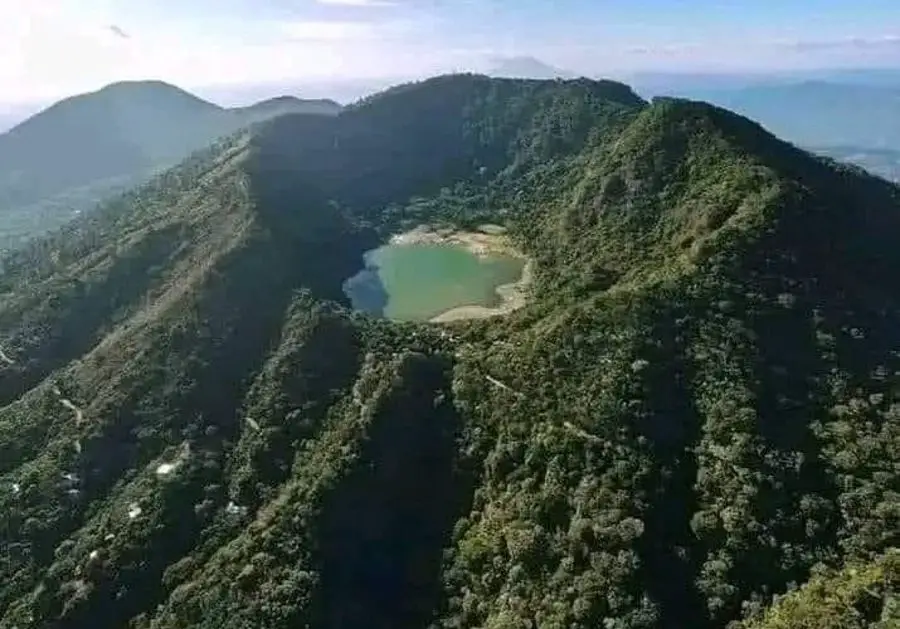
Best Way to Explore Salvadoran Volcanoes
There are two ways that these Salvadoran volcanoes can be appreciated and explored. One is to hike them, and the other one is to enjoy them from afar.
Hiking to the Summit
Hiking to the summit is the best way to explore and appreciate the beauty of these volcanoes; it is not an easy thing to do, but it is worth the effort to get it done.
The most accessible volcanoes that have excellent trails to reach the summit are El Boqueron, Santa Ana, and Izalco.
On the other hand, if you want a more challenging hike, try either the San Vicente or Chaparrastique volcanoes; these volcanoes have no official trails to the summit.
The trails leading up to the summit are dangerous and challenging. Therefore, the hikes are done in groups and led by a professional guide.
Appreciating the Volcanoes From Afar
If hiking is not your thing! But want to get a closer look at the phenomenal volcanoes. You can visit parks like El Boqueron or Los Volcanoes National Park; these national parks have open areas with great views of the volcanoes.
El Boqueron and Los Volcanoes National Park are not the only ones that have these lookout spots.
Each volcano has different ways that you can appreciate its beauty without having to reach the summit. So, depending on your location, the volcano near you might offer various activities or ways to view them.
The best way to decide what volcano to visit is to speak to a tour company in El Salvador and see what they recommend.
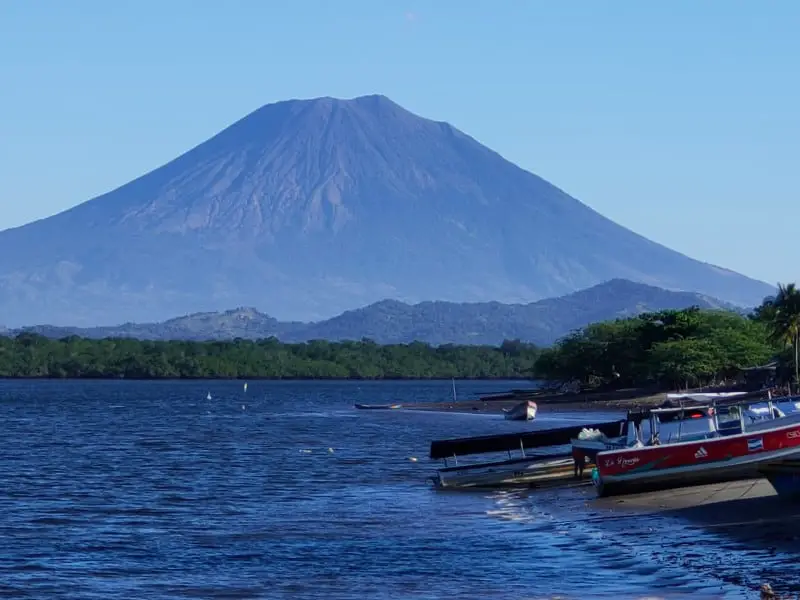
Volcano’s Importance to El Salvador
The Volcanoes in El Salvador have always been of great importance to the county. Volcanoes have been part of the cultural history of the country since pre-colonial times.
In the 21st century, Salvadoran volcanoes help produce clean energy, increase tourism, and help the coffee industry.
Geothermal Energy
El Salvador has geothermal plants that produce more than 20% percent of the total energy produced in El Salvador.
Geothermal energy, or heat from the earth, is a natural phenomenon associated with active volcanic systems. It uses the heat vented from volcanoes to create energy.
These geothermal fields are found throughout the volcanic chain that crosses the country, from the Ahuachapán area to the Conchagua volcano in the Gulf of Fonseca.
In 2021, the Nayib Bukele administration began using Volcano Geothermal energy for mining Bitcoins.
Tourism
Volcanoes are a large part of the Salvadoran tourism industry. Some of the most significant volcanoes to the tourist industry are the Santa Ana, Izalco, Cerro Verde, Conchagua, and San Salvador.
All the volcanoes in El Salvador offer unique qualities that tourists can see and enjoy throughout the year.
Coffee Production
El Salvador coffee production is a big part of the Salvadoran economy. It has also been part of the country’s history.
The best Salvadoran coffee beans come from lands around volcanoes. Volcanic soils are a big reason why Salvadoran coffee beans are well-known worldwide.
The Salvadoran Volcanoes
In conclusion, El Salvador’s volcanoes stand as both a geological wonder and a testament to the nation’s rich and complex history. These majestic peaks continue to shape the landscape and culture of this Central American country, showcasing the enduring power of nature.
Exploring the volcanos in El Salvador is one of the top things to do while visiting the country; here is a list of 23 volcanoes worth exploring.
| Name | Type | Altitude MASL |
Location | |
|---|---|---|---|---|
| 1 | Santa Ana | Stratovolcano | 2,382 | Santa Ana |
| 2 | Izalco | Stratovolcano | 1,965 | Sonsonate |
| 3 | San Salvador | Stratovolcano | 1,867 | San Salvador |
| 4 | San Vicente | Stratovolcano | 2,173 | San Vicente |
| 5 | Chaparrastique | Stratovolcano | 2,130 | San Miguel |
| 6 | 6a- Burnt Islands 6b- Ilopango |
Lava Dome Caldera |
450 438 |
San Salvador San Salvador |
| 7 | San Marcellino | Cinder Cone | 1,480 | Sonsonate |
| 8 | El Playon | Cinder Cone | 660 | San Salvador |
| 9 | Conchaguita | Stratovolcano | 550 | Fonseca Gulf |
| 10 | Coatepeque | Caldera | 746 | Santa Ana |
| 11 | Tecapa | Stratovolcano | 1,592 | Usulutan |
| 12 | Conchagua | Stratovolcano | 1,250 | La Union |
| 13 | Cuyanausul | Stratovolcano | 1,840 | Ahuachapan |
| 14 | El Pacayal | Stratovolcano | 1,200 | San Miguel |
| 15 | Limbo | Cinder Cone | 1,373 | San Miguel |
| 16 | Las Ranas Hill | Stratovolcano | 1,958 | Sonsonate |
| 17 | Green Lagoon | Stratovolcano | 1,829 | Ahuachapan |
| 18 | Las Ninfas Hill | Stratovolcano | 1,760 | Ahuachapan |
| 19 | Chingo | Stratovolcano | 1,777 | Santa Ana |
| 20 | Los Naranjos Hill | Stratovolcano | 1,960 | Sonsonate |
| 21 | Chambala Hill | Stratovolcano | 600 | San Miguel |
| 22 | Usulutan | Stratovolcano | 1,450 | Usulutan |
| 23 | Taburete Hill | Stratovolcano | 1,172 | Usulutan |

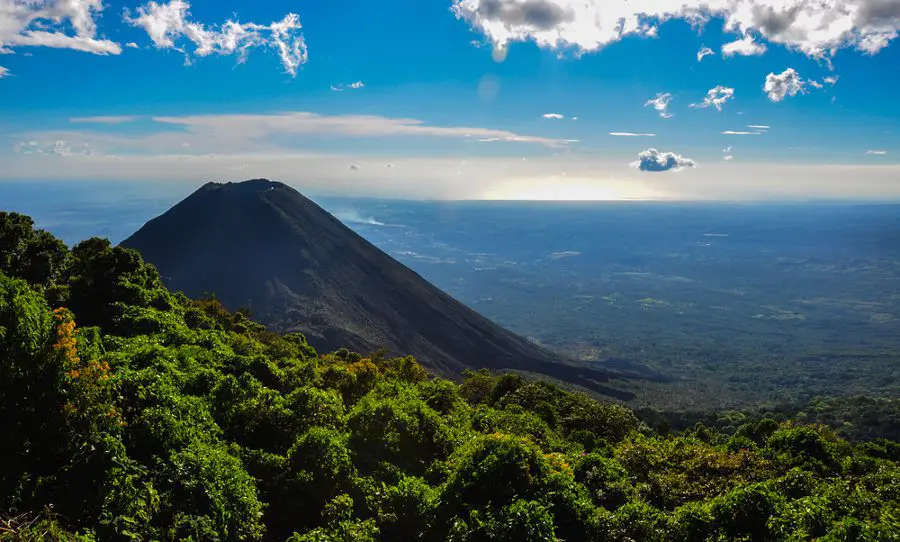 Cerro Verde National Park, El Salvador. Photo by
Cerro Verde National Park, El Salvador. Photo by 


